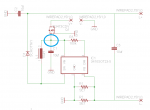rhd
0
- Joined
- Dec 7, 2010
- Messages
- 8,469
- Points
- 0
The mosfet isn't a part of the switching circuit though. I do see what you might be saying though, and the mosfet... well, may have problems.
If the voltage of the battery gets too low then the mosfet might not see all of the voltage it needs, and may potentially heat up/explode/smoke because it's stuck in its linear region.
And I checked up the part number on the LM3410, and it's the 1.6 mhz one. So, that's not the issue.
I don't necessarily think a low battery voltage would be an issue for this Mosfet. It has a threshold of 1V, that's pretty low.
But remember that we're sort of using it the reverse of how you'd normally conceptualize it. We're sort of counting on the current to first slip over the integrated shottky and open the gate from the other side, so to speak. Then the current would no longer flow over the shottky, and the drop between S and G would continue to keep the gate open.
What I'm saying (or suggesting / theorizing / brainstorming) is that the cycle above might keep repeating as the LM3410 goes through its cycle. It strikes me that when the LM3410 switches, it may break the input circuit long enough for the S and G differential to disappear, and the Mosfet to turn off.
Again, not a mosfet expert, but from what I understand of their theory, that's what I might expect to happen.






